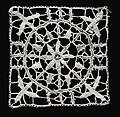Reticella

Reticella (also reticello or in French point coupé or point couppe) is a needle lace dating from the 15th century and remaining popular into the first quarter of the 17th century.
Reticella was originally a form of cutwork in which threads were pulled from linen fabric to make a "grid" on which the pattern was stitched, primarily using buttonhole stitch. Later reticella used a grid made of thread rather than a fabric ground. Both methods resulted in a characteristic geometric design of squares and circles with various arched or scalloped borders.
Books of patterns for reticella designed by Federico de Vinciolo (France, 1587) and Cesare Vecellio (Italy, probably from the 1590s but printed 1617) were popular and were frequently reprinted.
Reticella developed into Punto in Aria.
Gallery[edit]
-
Italy, 16th-17th century - Needlepoint (Reticella) Lace Square - 1920.1098 - Cleveland Museum of Art
-
Pattern for reticella or point couppe from Vinciolo's Les Singuliers et Nouveaux Pourtaicts, 1609 reprint of 1587 edition.
-
Nouveaux pourtraicts de point coupé
-
Sampler with needle lace and cutwork MET DP162636
-
Italy, Venice, 16th century - Needlepoint (Reticella) Lace Insertion - 1920.1073 - Cleveland Museum of Art
-
English woman wearing a reticella lace collar and cuffs tinted with yellow starch, c. 1614-1618
-
Kraag van linnen met tussenzetsel en schulpstroken in reticella, BK-1978-461
Notes[edit]
- ^ Ribeiro 2005, pp. 31-32
References[edit]
- Berry, Robin L.: "Reticella: a walk through the beginnings of Lace" (2004) (PDF)
- Kliot, Jules and Kaethe: The Needle-Made Lace of Reticella, Lacis Publications, Berkeley, CA, 1994. ISBN 0-916896-57-9.
- Montupet, Janine, and Ghislaine Schoeller: Lace: The Elegant Web, ISBN 0-8109-3553-8.
- Ribeiro, Aileen: Fashion and Fiction: Dress in Art and Literature in Stuart England, Yale, 2005, ISBN 0-300-10999-7
- Vinciolo, Federico: Renaissance Patterns for Lace, Embroidery and Needlepoint, Dover Books, 1971. ISBN 0-486-22438-4







